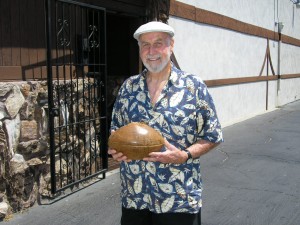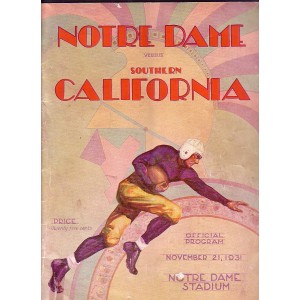With kickoff of the 2013 college football season less than a week away, I’ve been spending much of my downtime researching the Pac-12 and all of USC’s opponents for my regular in-season gig over at USCFootball.com. You can expect to see my annual Pac-12 preview there sometime in the next 72 hours or so, and a preview of next Thursday’s Trojan opener at Hawaii will likely go live there next Wednesday.
I’ve written a lot of football content since 2000, but was reminded of one very special story earlier this summer by some friends from my other professional life. About nine years ago, brothers Joel and Loren Crannell of Moulton Logistics introduced me to one of their family’s elders, a gentleman named Chuck Stump. Mr. Stump passed away last month after one heck of a life. And, as part of that life, he’d acquired a couple of pieces of simply incredible USC memorabilia. During the summer of 2004, at a lunch in the San Fernando Valley, I met Stump, heard his wonderful story and got to see these incredible pieces.
With Stump’s recent passing — and college football just around the corner — I felt it would be great to re-post the story that originally ran on USCFootball.com on August 6, 2004. Wherever you are today, Mr. Stump, thank you for sharing your great story. And to Joel and Loren: thanks for the opportunity to meet such a wonderful guy.
Honoring Old Champions Before the Latest Trojan Kickoff
Before Chuck Stump became a World War II paratrooper, he loved USC football — and he’s got the goods to prove it!
“As a young boy, I found it fascinating. They were like true superheroes back then — just like Flash Gordon or Prince Valiant or the Roman and Greek warriors we heard about in school,” says Charles “Chuck” Stump, while clutching a USC game ball from the 1932 Rose Bowl, in which the Trojans upended Tulane, 21-12, to win the school’s second national title. “In that era of the late 1920s through the 1930s, I went with my dad Clark to every game we could down at the Coliseum.”
The octogenarian, who has lived in the San Fernando Valley for more than six decades now, went on to become a hero in his own right — a member of the 11th Airborne from 1943-47. “We were among the first occupation troops in Japan,” Stump says, downplaying his battle wounds that he says were “field dressed” before he went immediately back to work. “I jumped into New Guinea, Luzon and many other areas. We were training for the invasion of Japan before the A-bombs were dropped in Hiroshima and Nagasaki.”
But it was those memories of USC football as a youngster that helped form Stump’s vision of heroism. And, not only does Stump still have that game ball, with a number of autographs from famed Trojans of the day, he also still owns an original version of the “Howard Jones All-American Football” board game, signed by Jones and a couple of Trojan standouts.
“The game is totally different from today’s football,” Stump says, pointing out just how far football has come from the days of running back Gus Shaver to the aerial attack of Matt Leinart. “It’s all the old style plays — all running plays. Passing plays all have a very low chance of success in this game.”
Stump credits his aunt, Laura Hadlock, who worked for the Los Angeles City Parks Department for getting his father access to game tickets. “We had every program from all the games we went to. We met the big players of that era, like Cotton Warburton, and I also met Howard Jones,” Stump adds. “We also went to the ’32 Olympics when they were at the Coliseum. Unfortunately, when I went into the war, my mom was against me joining. While I was gone, she gave away most of the things I had collected from those games.”
Still, his cousin, Frank Hadlock, had access to some USC memorabilia and found the game ball and board game to give to Stump. The ball, which had begun to deteriorate, needed some help. “My dad went over the autographs in India ink, took out the rotted bladder and packed it with paper, and then shellacked the ball to preserve it,”
That football is a truly wondrous piece of memorabilia, featuring hand-written scores of each game in USC’s 10-1 1931 national title season, an etched interlocking “SC” logo, and the autographs of Trojan greats like Orv Mohler, Johnny Baker, Gus Shaver and Tay Brown. The archaic board game is still in excellent condition, considering it’s made of cardboard and many of the game pieces are wood.
The 1931 Trojan team, which featured All-Americans Baker, Shaver, Stan Williamson and Erny Pinckert, lost its opening game to St. Mary’s, 13-7, before running off 10 consecutive victories, including shutouts of Oregon State, Oregon, California, Stanford, Montana and Georgia. However, its most memorable triumph was a see-to-believe 16-14 comeback victory over Notre Dame in South Bend on Nov. 21.
Trailing 14-0 to begin the fourth quarter, Mohler’s passing and Shaver’s running narrowed the Irish lead to 14-13, before Baker’s 33-yard field goal with a minute to play sealed a Trojan victory that made national headlines. When the USC team returned to Los Angeles via train, a crowd estimated at 300,000 welcomed the Trojans with a parade through downtown Los Angeles.
It was that kind of passion that Clark and Chuck Stump shared for USC football. When the younger Stump went off to war, his father kept him in touch with Trojan football. “My dad would listen to the games on the radio and chart all the plays for me,” Stump contends. “He used charting paper from the power plants he worked at, and would send me the game charts wherever I was based.”
After returning home and settling down in Van Nuys, Stump started his own trucking company for a time, before becoming a driver. He lost interest in college sports as time went on, citing the down era at USC in the 1940s and 1950s, and excessive changes of coaches and players. “There was just too much jumping around for me,” Stump says. “Back when I was going, you knew Jones would be the coach and the players would be a certain type of man. Things changed and I lost touch.”
Still, Stump revels in those childhood memories of cardinal and gold afternoons in the Coliseum with his father. And the 72-year old football is the greatest reminder of those times for him.
For the rest of us, as we close in on the start of another season of USC football, that football and a story like Chuck Stump’s are a reminder of just how deeply felt and long-lasting is the Trojan tradition.
(Originally published August 6, 2004 on USCFootball.com)



